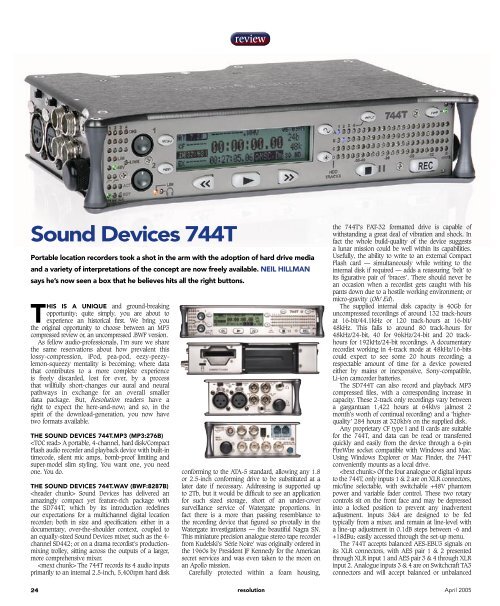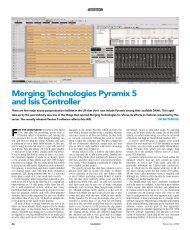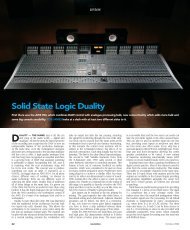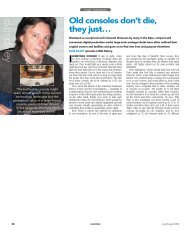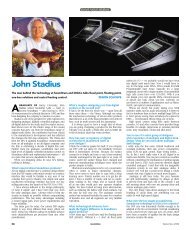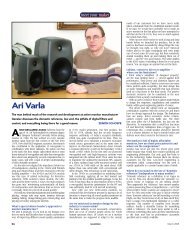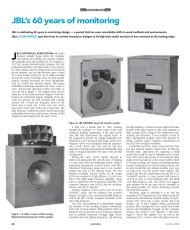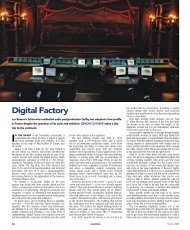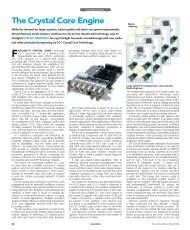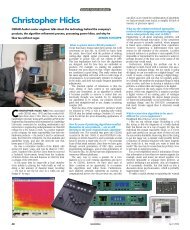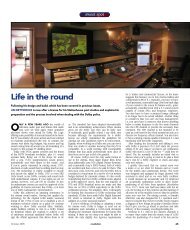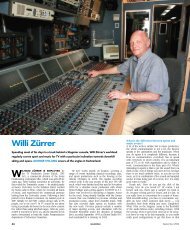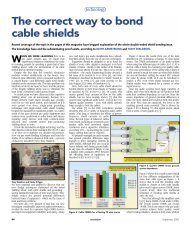Sound Devices 744T - Resolution
Sound Devices 744T - Resolution
Sound Devices 744T - Resolution
Create successful ePaper yourself
Turn your PDF publications into a flip-book with our unique Google optimized e-Paper software.
eview<br />
<strong>Sound</strong> <strong>Devices</strong> <strong>744T</strong><br />
Portable location recorders took a shot in the arm with the adoption of hard drive media<br />
and a variety of interpretations of the concept are now freely available. NEIL HILLMAN<br />
says he’s now seen a box that he believes hits all the right buttons.<br />
THIS IS A UNIQUE and ground-breaking<br />
opportunity; quite simply, you are about to<br />
experience an historical first. We bring you<br />
the original opportunity to choose between an MP3<br />
compressed review or, an uncompressed .BWF version.<br />
As fellow audio-professionals, I’m sure we share<br />
the same reservations about how prevalent this<br />
lossy-compression, iPod, pea-pod, eezy-peezylemon-squeezy<br />
mentality is becoming; where data<br />
that contributes to a more complete experience<br />
is freely discarded, lost for ever, by a process<br />
that willfully short-changes our aural and neural<br />
pathways in exchange for an overall smaller<br />
data package. But, <strong>Resolution</strong> readers have a<br />
right to expect the here-and-now; and so, in the<br />
spirit of the download-generation, you now have<br />
two formats available.<br />
THE SOUND DEVICES <strong>744T</strong>.MP3 (MP3:276B)<br />
A portable, 4-channel, hard disk/Compact<br />
Flash audio recorder and playback device with built-in<br />
timecode, silent mic amps, bomb-proof limiting and<br />
super-model slim styling. You want one, you need<br />
one. You do.<br />
THE SOUND DEVICES <strong>744T</strong>.WAV (BWF:8287B)<br />
<strong>Sound</strong> <strong>Devices</strong> has delivered an<br />
amazingly compact yet feature-rich package with<br />
the SD<strong>744T</strong>, which by its introduction redefines<br />
our expectations for a multichannel digital location<br />
recorder; both in size and specification: either in a<br />
documentary, over-the-shoulder context, coupled to<br />
an equally-sized <strong>Sound</strong> <strong>Devices</strong> mixer, such as the 4-<br />
channel SD442; or on a drama recordist’s productionmixing<br />
trolley, sitting across the outputs of a larger,<br />
more comprehensive mixer.<br />
The <strong>744T</strong> records its 4 audio inputs<br />
primarily to an internal 2.5-inch, 5,400rpm hard disk<br />
conforming to the ATA-5 standard, allowing any 1.8<br />
or 2.5-inch conforming drive to be substituted at a<br />
later date if necessary. Addressing is supported up<br />
to 2Tb, but it would be difficult to see an application<br />
for such sized storage, short of an under-cover<br />
surveillance service of Watergate proportions. In<br />
fact there is a more than passing resemblance to<br />
the recording device that figured so pivotally in the<br />
Watergate investigations — the beautiful Nagra SN.<br />
This miniature precision analogue stereo tape recorder<br />
from Kudelski’s ‘Série Noire’ was originally ordered in<br />
the 1960s by President JF Kennedy for the American<br />
secret services and was even taken to the moon on<br />
an Apollo mission.<br />
Carefully protected within a foam housing,<br />
the <strong>744T</strong>’s FAT-32 formatted drive is capable of<br />
withstanding a great deal of vibration and shock. In<br />
fact the whole build-quality of the device suggests<br />
a lunar mission could be well within its capabilities.<br />
Usefully, the ability to write to an external Compact<br />
Flash card — simultaneously while writing to the<br />
internal disk if required — adds a reassuring ‘belt’ to<br />
its figurative pair of ‘braces’. There should never be<br />
an occasion when a recordist gets caught with his<br />
pants down due to a hostile working environment; or<br />
micro-gravity (Oh! Ed).<br />
The supplied internal disk capacity is 40Gb for<br />
uncompressed recordings of around 132 track-hours<br />
at 16-bit/44.1kHz or 120 track-hours at 16-bit/<br />
48kHz. This falls to around 80 track-hours for<br />
48kHz/24-bit, 40 for 96kHz/24-bit and 20 trackhours<br />
for 192kHz/24-bit recordings. A documentary<br />
recordist working in 4-track mode at 48kHz/16-bits<br />
could expect to see some 20 hours recording; a<br />
respectable amount of time for a device powered<br />
either by mains or inexpensive, Sony-compatible,<br />
Li-ion camcorder batteries.<br />
The SD<strong>744T</strong> can also record and playback MP3<br />
compressed files, with a corresponding increase in<br />
capacity. These 2-track only recordings vary between<br />
a gargantuan 1,422 hours at 64kb/s (almost 2<br />
month’s worth of continual recording) and a ‘higherquality’<br />
284 hours at 320kb/s on the supplied disk.<br />
Any proprietary CF type I and II cards are suitable<br />
for the <strong>744T</strong>, and data can be read or transferred<br />
quickly and easily from the device through a 6-pin<br />
FireWire socket compatible with Windows and Mac.<br />
Using Windows Explorer or Mac Finder, the <strong>744T</strong><br />
conveniently mounts as a local drive.<br />
Of the four analogue or digital inputs<br />
to the <strong>744T</strong>, only inputs 1 & 2 are on XLR connectors,<br />
mic/line selectable, with switchable +48V phantom<br />
power and variable fader control. These two rotary<br />
controls sit on the front face and may be depressed<br />
into a locked position to prevent any inadvertent<br />
adjustment. Inputs 3&4 are designed to be fed<br />
typically from a mixer, and remain at line-level with<br />
a line-up adjustment in 0.1dB steps between -6 and<br />
+18dBu; easily accessed through the set-up menu.<br />
The <strong>744T</strong> accepts balanced AES-EBU3 signals on<br />
its XLR connectors, with AES pair 1 & 2 presented<br />
through XLR input 1 and AES pair 3 & 4 through XLR<br />
input 2. Analogue inputs 3 & 4 are on Switchcraft TA3<br />
connectors and will accept balanced or unbalanced<br />
24 resolution April 2005
eview<br />
signals, while digital inputs 3 & 4 are available on<br />
BNC connectors as an AES3id or SPDIF signal with<br />
the recorder automatically detecting the signal type.<br />
A digital signal at the BNC connector will override an<br />
analogue signal present on the XLR inputs, although<br />
through the set-up menu it is possible to input<br />
analogue audio while using the AES3id input as a<br />
digital clock source.<br />
Any input may be routed to any track, and multiple<br />
inputs may be routed to a single track to create a<br />
mono-mix. A 4 x 4 matrix of blue LEDs on the front<br />
panel make it easy to see where each input is routed<br />
to, and in fact, a quick scan by a new operator’s eyes<br />
across the front panel, soon establishes a confidence<br />
in the performance and status of the recorder.<br />
Headphone monitoring is comprehensive across<br />
the inputs, tracks and post-record tracks, with 10<br />
preset routings including an MS decoding matrix<br />
selectable for either of the stereo inputs, and a further<br />
10 user-defined combinations available through the<br />
easily navigated set-up menu. A form of confidence<br />
monitoring is also possible, allowing the internal disk,<br />
or the CF card, to be listened to while the machine is in<br />
record; although the record buffer introduces a delay<br />
of up to 12 seconds. Operating the device is pleasingly<br />
direct — if you can work a tape recorder, you can<br />
record and playback from the SD<strong>744T</strong>.<br />
Metering on the <strong>744T</strong> is similar to that found on<br />
other <strong>Sound</strong> <strong>Devices</strong> equipment: bright, high-intensity<br />
LEDs with selectable ballistics between VU and Peak,<br />
and a non-linear metering scale differentiated by<br />
different coloured lights. From -50dbFS to -40dBFS,<br />
each LED segment equates to 10dB; from -40dBFS<br />
to -12dBFS each segment equals 2dB, and from<br />
-12dBFS to 0dBFS each LED represents 4dB. Set to<br />
VU plus Peak Hold it doesn’t take too long to forget<br />
white numbers on a black background, and a needle<br />
swinging wildly between 1 and 7.<br />
The mechanics of the set-up menu are<br />
straightforward for any recordist familiar with working<br />
a time code and file handling device; and satisfyingly<br />
un-daunting enough for those who aren’t. While there<br />
are many permutations available, variables like bitdepth<br />
and sample rate are easily arrived at and several<br />
‘soft key’ short-cuts are usefully given in the user’s<br />
manual for the most frequently adjusted settings.<br />
The <strong>744T</strong>’s file-handling is a standard FAT-32<br />
Directory/File hierarchical architecture; formatted as a<br />
single volume, with the recorded files being placed into<br />
a master directory called ‘<strong>Sound</strong>dev’. File names are<br />
made up from four elements: Scene Number (‘Sxxx’,<br />
user-set), Take Number (‘Txxx’, auto-incrementing),<br />
mono file designator (‘1-4’ if a mono file is selected),<br />
and the file extension (either .BWF or MP3). A ‘Daily<br />
Folder’ sub-directory may also be created if required,<br />
so on power-up that day’s recordings are automatically<br />
placed into a correspondingly time-stamped folder.<br />
The <strong>Sound</strong> <strong>Devices</strong> SD<strong>744T</strong>, a<br />
compact 4-channel recorder with an obligatory — and<br />
comprehensive — time code capability, has a designphilosophy<br />
that makes it the worthy and natural<br />
successor to the now elderly Fostex PD4 or HHB<br />
PDR1000TC time code DAT machines; both of which<br />
became the recorders of choice for a whole generation<br />
of sound recordists and sold by the container shipfull.<br />
When those models went out of production some<br />
time ago, with Fostex and HHB opting to change their<br />
recording formats and modernise their recorder range<br />
with ones of greater size, weight and cost — paving<br />
the way for an increase in performance and overall<br />
data-capacity — a hole was left in the market for<br />
sound recordists who needed something as simple<br />
and as easily portable as those earlier machines.<br />
Fostex responded with their attractively-priced and<br />
highly-capable 2-channel CF recorder, the Fostex<br />
FR-2; but this middle-ground, middle-budget market<br />
has been blown into disarray by the emergence of the<br />
<strong>Sound</strong> <strong>Devices</strong> <strong>744T</strong>.<br />
Compact yet capacious, with its 4-track flexibility<br />
the <strong>744T</strong> has put the cat among the pigeons in the<br />
world of location recorders. If you are a professional<br />
location recordist, then by default you are in the<br />
market for this highly portable, hard disk/Compact<br />
Flash audio recorder and playback device. With<br />
its built-in time code, silent mic amps, bomb-proof<br />
limiting and super-model slim styling, you want one<br />
and you need one. You really, really do. ■<br />
PROS<br />
CONS<br />
Contact<br />
Priced strategically between its competitors,<br />
the SD<strong>744T</strong>’s value for money at UK£3,700 —<br />
like its size and styling — is highly attractive.<br />
Call me old-fashioned, but in the absence<br />
of a PPM I’d still prefer an LCD peak-hold<br />
bargraph as opposed to the aurora borealis<br />
nature of the <strong>Sound</strong> <strong>Devices</strong>’ trade-mark<br />
metering. My retinas would appreciate it too.<br />
SOUND DEVICES, US<br />
Website: www.sounddevices.com<br />
UK, Shure Dsictribution: +44 208 808 2222<br />
April 2005<br />
resolution<br />
25


